VET656: Undernutrition Study in Children, Lahore, Pakistan
VerifiedAdded on 2022/11/01
|13
|3613
|2
Report
AI Summary
This report presents a comprehensive research proposal focused on the status of undernutrition in children aged two years and below in Lahore, Pakistan. The study aims to ascertain the prevalence of undernutrition and identify associated risk factors, utilizing a case-control study design at the Children's Hospital in Lahore. The methodology includes a multistage cluster sampling approach, employing a semi-structured questionnaire administered to mothers, with a sample size of 100 cases and 200 controls. Data analysis will be conducted using SPSS version 20, incorporating descriptive and quantitative statistical methods. Ethical considerations such as informed consent and voluntary withdrawal are addressed. The proposal anticipates outcomes highlighting the impact of maternal literacy, environmental factors, and income levels on undernutrition. The findings are expected to inform public health policy and interventions aimed at improving child health outcomes. The study's limitations, including sample size and potential for researcher bias, are also acknowledged, along with proposed mitigation strategies.
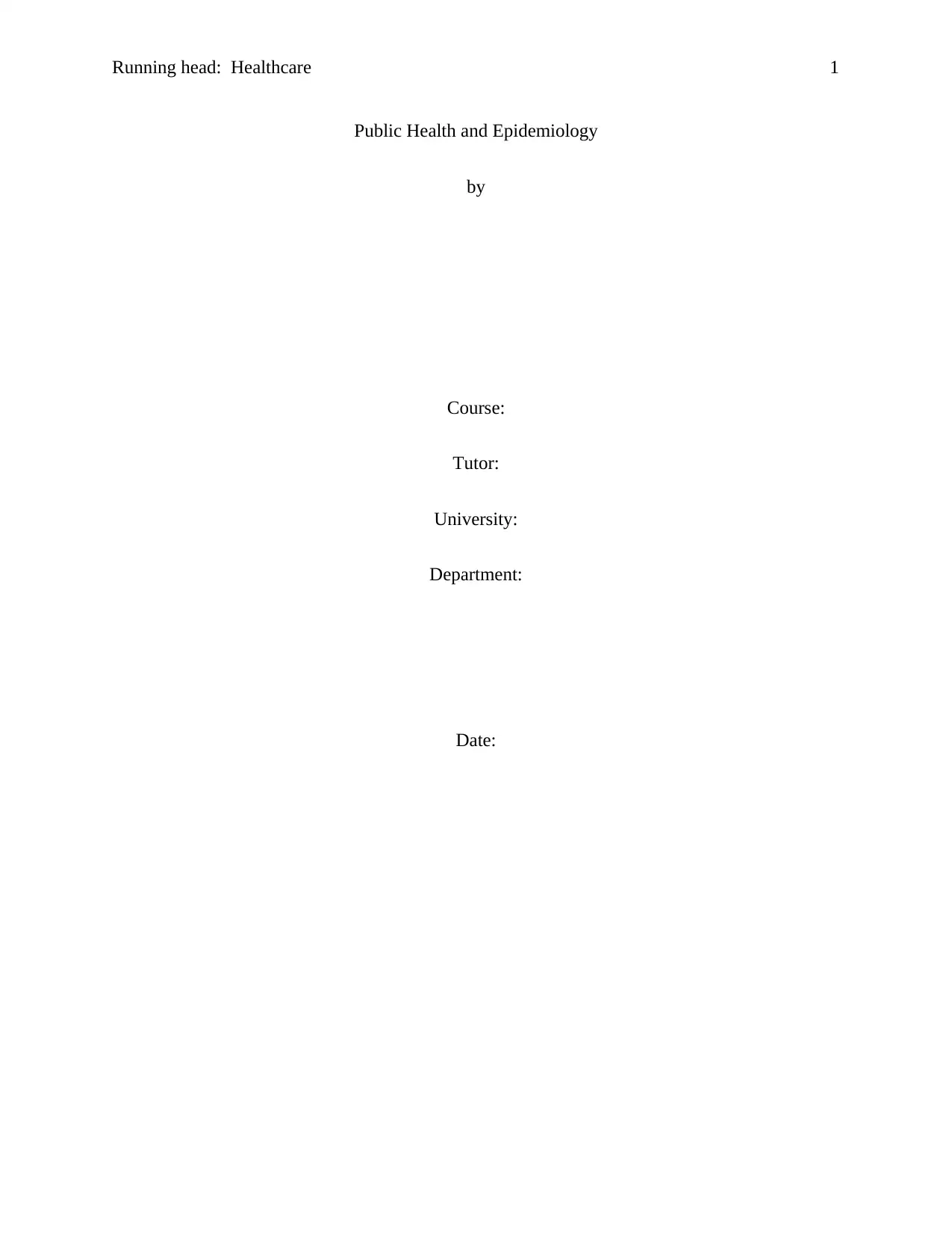
Running head: Healthcare 1
Public Health and Epidemiology
by
Course:
Tutor:
University:
Department:
Date:
Public Health and Epidemiology
by
Course:
Tutor:
University:
Department:
Date:
Paraphrase This Document
Need a fresh take? Get an instant paraphrase of this document with our AI Paraphraser
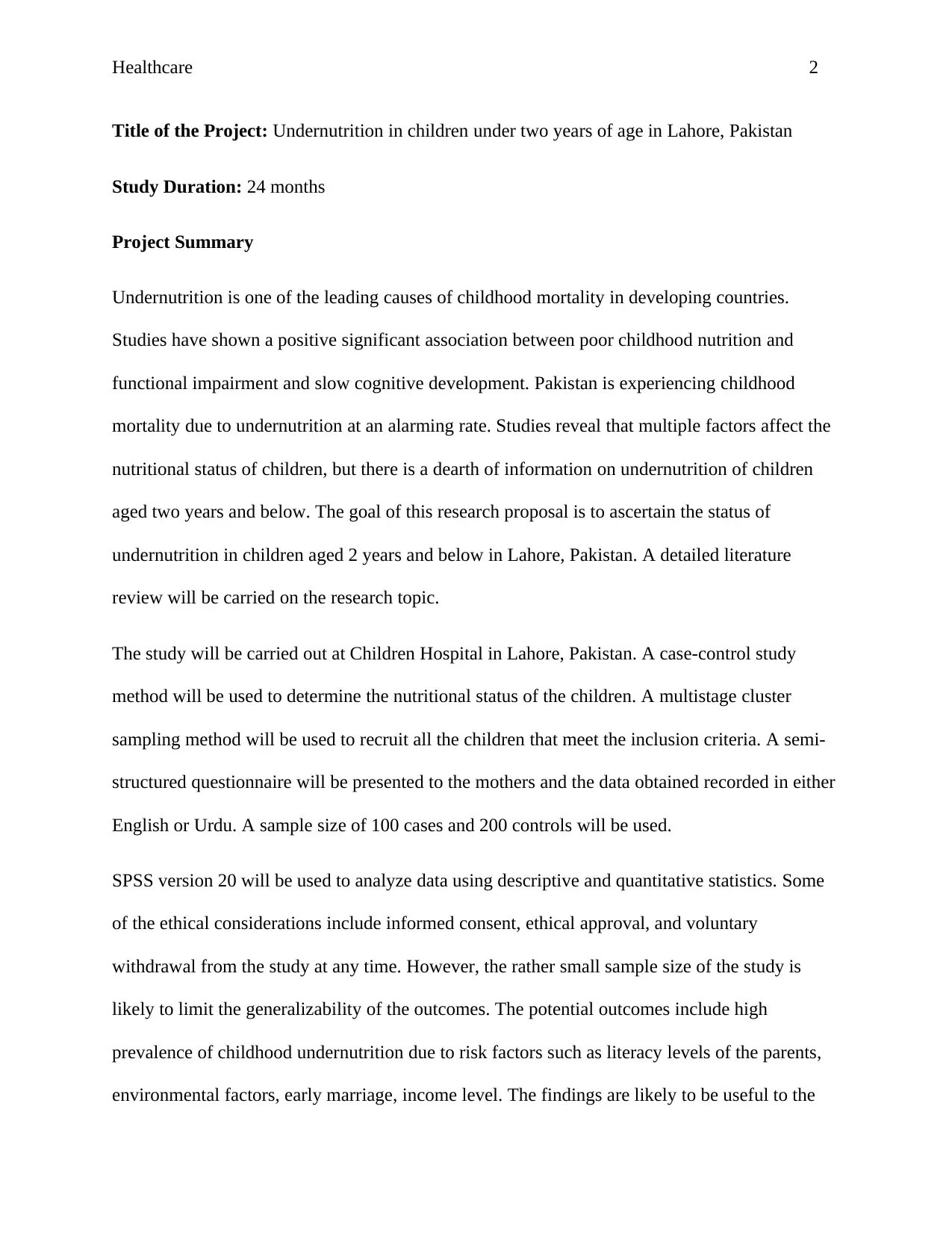
Healthcare 2
Title of the Project: Undernutrition in children under two years of age in Lahore, Pakistan
Study Duration: 24 months
Project Summary
Undernutrition is one of the leading causes of childhood mortality in developing countries.
Studies have shown a positive significant association between poor childhood nutrition and
functional impairment and slow cognitive development. Pakistan is experiencing childhood
mortality due to undernutrition at an alarming rate. Studies reveal that multiple factors affect the
nutritional status of children, but there is a dearth of information on undernutrition of children
aged two years and below. The goal of this research proposal is to ascertain the status of
undernutrition in children aged 2 years and below in Lahore, Pakistan. A detailed literature
review will be carried on the research topic.
The study will be carried out at Children Hospital in Lahore, Pakistan. A case-control study
method will be used to determine the nutritional status of the children. A multistage cluster
sampling method will be used to recruit all the children that meet the inclusion criteria. A semi-
structured questionnaire will be presented to the mothers and the data obtained recorded in either
English or Urdu. A sample size of 100 cases and 200 controls will be used.
SPSS version 20 will be used to analyze data using descriptive and quantitative statistics. Some
of the ethical considerations include informed consent, ethical approval, and voluntary
withdrawal from the study at any time. However, the rather small sample size of the study is
likely to limit the generalizability of the outcomes. The potential outcomes include high
prevalence of childhood undernutrition due to risk factors such as literacy levels of the parents,
environmental factors, early marriage, income level. The findings are likely to be useful to the
Title of the Project: Undernutrition in children under two years of age in Lahore, Pakistan
Study Duration: 24 months
Project Summary
Undernutrition is one of the leading causes of childhood mortality in developing countries.
Studies have shown a positive significant association between poor childhood nutrition and
functional impairment and slow cognitive development. Pakistan is experiencing childhood
mortality due to undernutrition at an alarming rate. Studies reveal that multiple factors affect the
nutritional status of children, but there is a dearth of information on undernutrition of children
aged two years and below. The goal of this research proposal is to ascertain the status of
undernutrition in children aged 2 years and below in Lahore, Pakistan. A detailed literature
review will be carried on the research topic.
The study will be carried out at Children Hospital in Lahore, Pakistan. A case-control study
method will be used to determine the nutritional status of the children. A multistage cluster
sampling method will be used to recruit all the children that meet the inclusion criteria. A semi-
structured questionnaire will be presented to the mothers and the data obtained recorded in either
English or Urdu. A sample size of 100 cases and 200 controls will be used.
SPSS version 20 will be used to analyze data using descriptive and quantitative statistics. Some
of the ethical considerations include informed consent, ethical approval, and voluntary
withdrawal from the study at any time. However, the rather small sample size of the study is
likely to limit the generalizability of the outcomes. The potential outcomes include high
prevalence of childhood undernutrition due to risk factors such as literacy levels of the parents,
environmental factors, early marriage, income level. The findings are likely to be useful to the
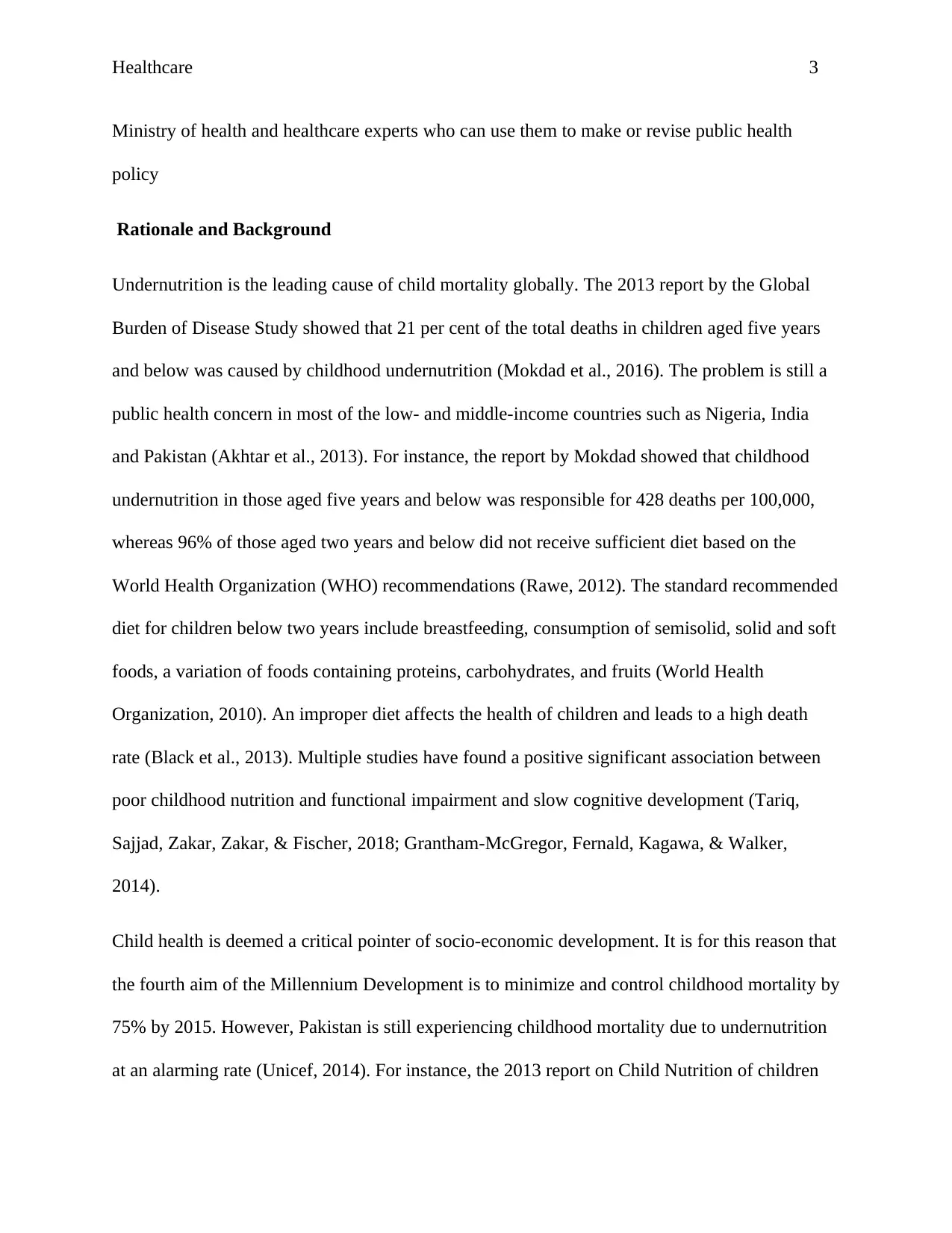
Healthcare 3
Ministry of health and healthcare experts who can use them to make or revise public health
policy
Rationale and Background
Undernutrition is the leading cause of child mortality globally. The 2013 report by the Global
Burden of Disease Study showed that 21 per cent of the total deaths in children aged five years
and below was caused by childhood undernutrition (Mokdad et al., 2016). The problem is still a
public health concern in most of the low- and middle-income countries such as Nigeria, India
and Pakistan (Akhtar et al., 2013). For instance, the report by Mokdad showed that childhood
undernutrition in those aged five years and below was responsible for 428 deaths per 100,000,
whereas 96% of those aged two years and below did not receive sufficient diet based on the
World Health Organization (WHO) recommendations (Rawe, 2012). The standard recommended
diet for children below two years include breastfeeding, consumption of semisolid, solid and soft
foods, a variation of foods containing proteins, carbohydrates, and fruits (World Health
Organization, 2010). An improper diet affects the health of children and leads to a high death
rate (Black et al., 2013). Multiple studies have found a positive significant association between
poor childhood nutrition and functional impairment and slow cognitive development (Tariq,
Sajjad, Zakar, Zakar, & Fischer, 2018; Grantham-McGregor, Fernald, Kagawa, & Walker,
2014).
Child health is deemed a critical pointer of socio-economic development. It is for this reason that
the fourth aim of the Millennium Development is to minimize and control childhood mortality by
75% by 2015. However, Pakistan is still experiencing childhood mortality due to undernutrition
at an alarming rate (Unicef, 2014). For instance, the 2013 report on Child Nutrition of children
Ministry of health and healthcare experts who can use them to make or revise public health
policy
Rationale and Background
Undernutrition is the leading cause of child mortality globally. The 2013 report by the Global
Burden of Disease Study showed that 21 per cent of the total deaths in children aged five years
and below was caused by childhood undernutrition (Mokdad et al., 2016). The problem is still a
public health concern in most of the low- and middle-income countries such as Nigeria, India
and Pakistan (Akhtar et al., 2013). For instance, the report by Mokdad showed that childhood
undernutrition in those aged five years and below was responsible for 428 deaths per 100,000,
whereas 96% of those aged two years and below did not receive sufficient diet based on the
World Health Organization (WHO) recommendations (Rawe, 2012). The standard recommended
diet for children below two years include breastfeeding, consumption of semisolid, solid and soft
foods, a variation of foods containing proteins, carbohydrates, and fruits (World Health
Organization, 2010). An improper diet affects the health of children and leads to a high death
rate (Black et al., 2013). Multiple studies have found a positive significant association between
poor childhood nutrition and functional impairment and slow cognitive development (Tariq,
Sajjad, Zakar, Zakar, & Fischer, 2018; Grantham-McGregor, Fernald, Kagawa, & Walker,
2014).
Child health is deemed a critical pointer of socio-economic development. It is for this reason that
the fourth aim of the Millennium Development is to minimize and control childhood mortality by
75% by 2015. However, Pakistan is still experiencing childhood mortality due to undernutrition
at an alarming rate (Unicef, 2014). For instance, the 2013 report on Child Nutrition of children
⊘ This is a preview!⊘
Do you want full access?
Subscribe today to unlock all pages.

Trusted by 1+ million students worldwide
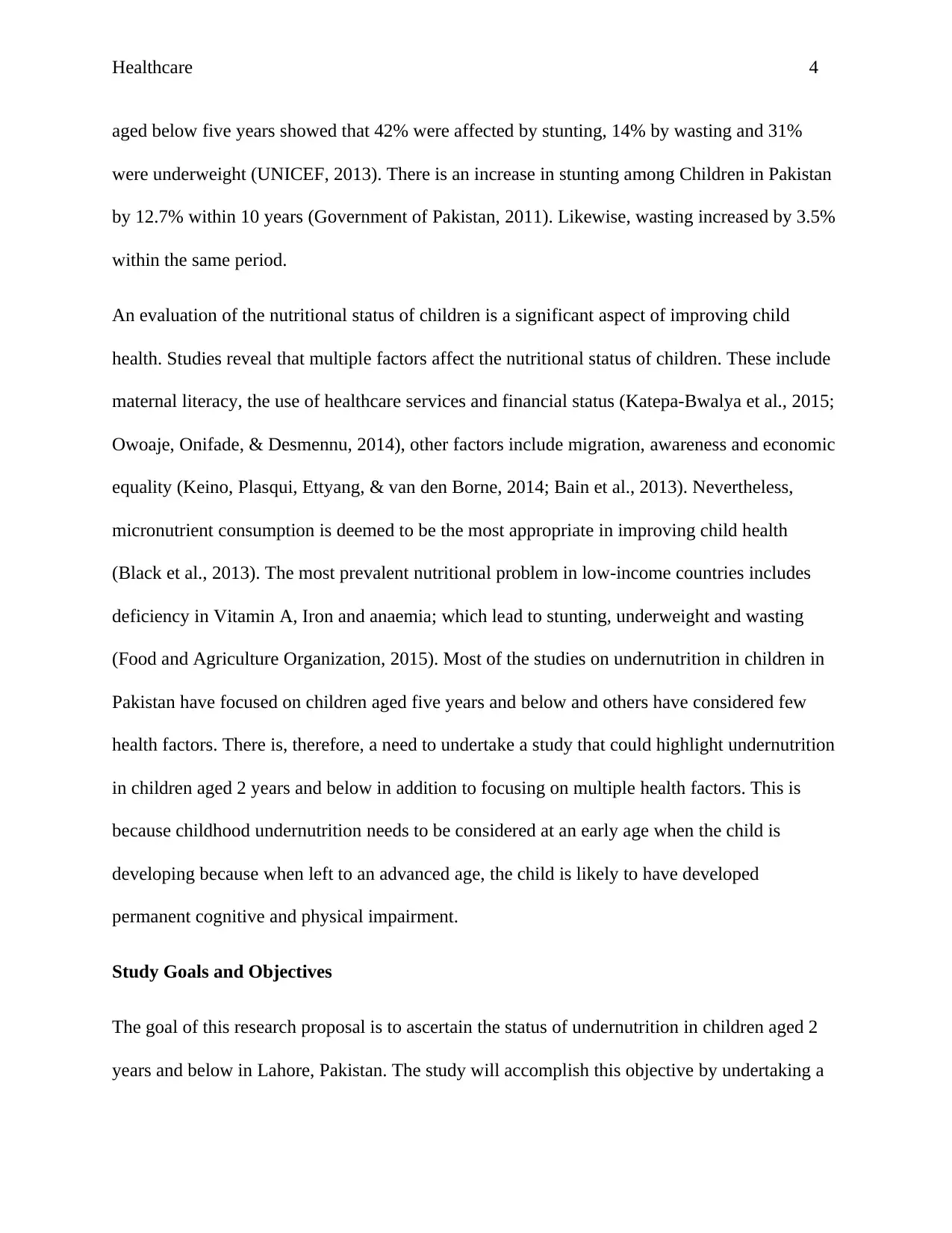
Healthcare 4
aged below five years showed that 42% were affected by stunting, 14% by wasting and 31%
were underweight (UNICEF, 2013). There is an increase in stunting among Children in Pakistan
by 12.7% within 10 years (Government of Pakistan, 2011). Likewise, wasting increased by 3.5%
within the same period.
An evaluation of the nutritional status of children is a significant aspect of improving child
health. Studies reveal that multiple factors affect the nutritional status of children. These include
maternal literacy, the use of healthcare services and financial status (Katepa-Bwalya et al., 2015;
Owoaje, Onifade, & Desmennu, 2014), other factors include migration, awareness and economic
equality (Keino, Plasqui, Ettyang, & van den Borne, 2014; Bain et al., 2013). Nevertheless,
micronutrient consumption is deemed to be the most appropriate in improving child health
(Black et al., 2013). The most prevalent nutritional problem in low-income countries includes
deficiency in Vitamin A, Iron and anaemia; which lead to stunting, underweight and wasting
(Food and Agriculture Organization, 2015). Most of the studies on undernutrition in children in
Pakistan have focused on children aged five years and below and others have considered few
health factors. There is, therefore, a need to undertake a study that could highlight undernutrition
in children aged 2 years and below in addition to focusing on multiple health factors. This is
because childhood undernutrition needs to be considered at an early age when the child is
developing because when left to an advanced age, the child is likely to have developed
permanent cognitive and physical impairment.
Study Goals and Objectives
The goal of this research proposal is to ascertain the status of undernutrition in children aged 2
years and below in Lahore, Pakistan. The study will accomplish this objective by undertaking a
aged below five years showed that 42% were affected by stunting, 14% by wasting and 31%
were underweight (UNICEF, 2013). There is an increase in stunting among Children in Pakistan
by 12.7% within 10 years (Government of Pakistan, 2011). Likewise, wasting increased by 3.5%
within the same period.
An evaluation of the nutritional status of children is a significant aspect of improving child
health. Studies reveal that multiple factors affect the nutritional status of children. These include
maternal literacy, the use of healthcare services and financial status (Katepa-Bwalya et al., 2015;
Owoaje, Onifade, & Desmennu, 2014), other factors include migration, awareness and economic
equality (Keino, Plasqui, Ettyang, & van den Borne, 2014; Bain et al., 2013). Nevertheless,
micronutrient consumption is deemed to be the most appropriate in improving child health
(Black et al., 2013). The most prevalent nutritional problem in low-income countries includes
deficiency in Vitamin A, Iron and anaemia; which lead to stunting, underweight and wasting
(Food and Agriculture Organization, 2015). Most of the studies on undernutrition in children in
Pakistan have focused on children aged five years and below and others have considered few
health factors. There is, therefore, a need to undertake a study that could highlight undernutrition
in children aged 2 years and below in addition to focusing on multiple health factors. This is
because childhood undernutrition needs to be considered at an early age when the child is
developing because when left to an advanced age, the child is likely to have developed
permanent cognitive and physical impairment.
Study Goals and Objectives
The goal of this research proposal is to ascertain the status of undernutrition in children aged 2
years and below in Lahore, Pakistan. The study will accomplish this objective by undertaking a
Paraphrase This Document
Need a fresh take? Get an instant paraphrase of this document with our AI Paraphraser
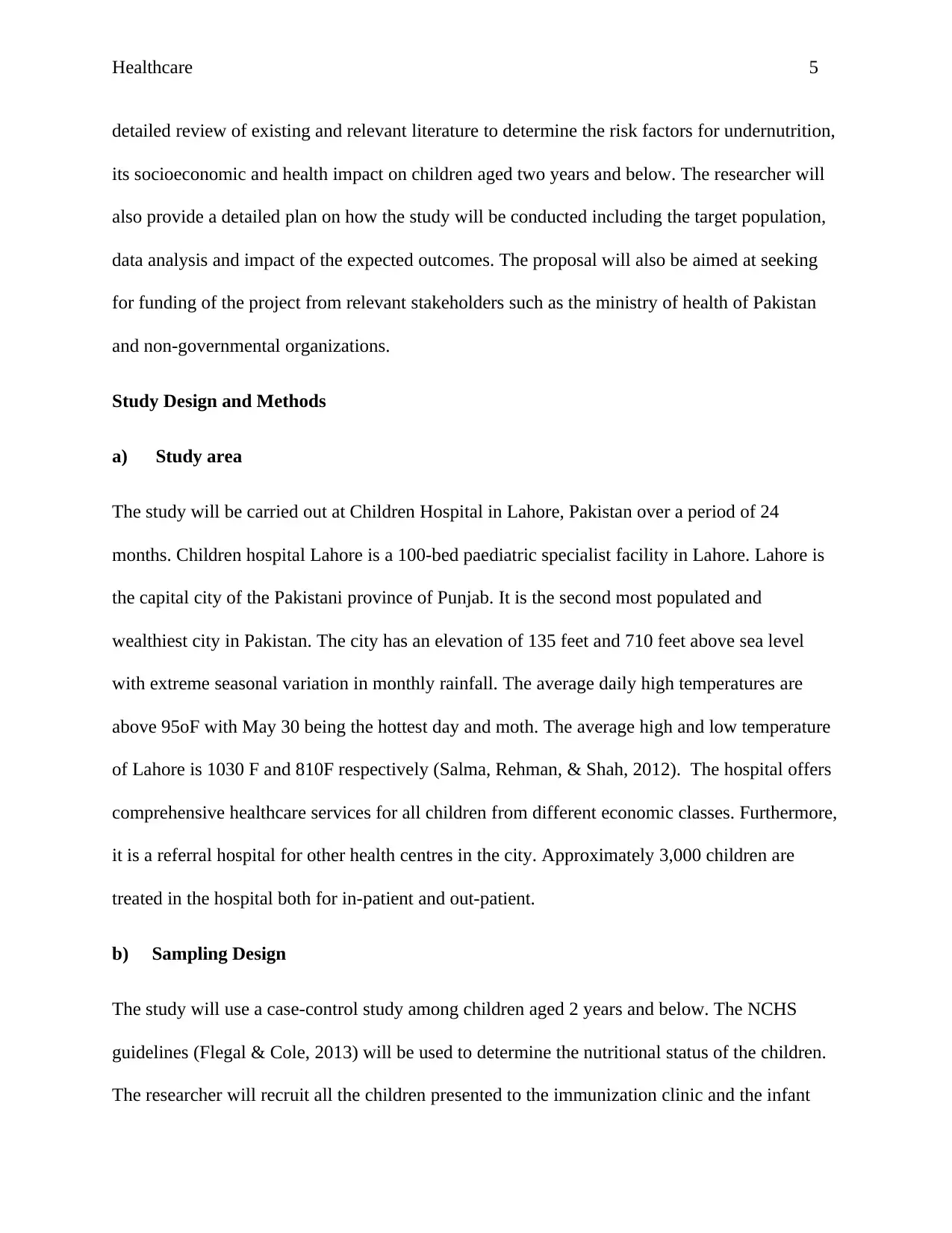
Healthcare 5
detailed review of existing and relevant literature to determine the risk factors for undernutrition,
its socioeconomic and health impact on children aged two years and below. The researcher will
also provide a detailed plan on how the study will be conducted including the target population,
data analysis and impact of the expected outcomes. The proposal will also be aimed at seeking
for funding of the project from relevant stakeholders such as the ministry of health of Pakistan
and non-governmental organizations.
Study Design and Methods
a) Study area
The study will be carried out at Children Hospital in Lahore, Pakistan over a period of 24
months. Children hospital Lahore is a 100-bed paediatric specialist facility in Lahore. Lahore is
the capital city of the Pakistani province of Punjab. It is the second most populated and
wealthiest city in Pakistan. The city has an elevation of 135 feet and 710 feet above sea level
with extreme seasonal variation in monthly rainfall. The average daily high temperatures are
above 95oF with May 30 being the hottest day and moth. The average high and low temperature
of Lahore is 1030 F and 810F respectively (Salma, Rehman, & Shah, 2012). The hospital offers
comprehensive healthcare services for all children from different economic classes. Furthermore,
it is a referral hospital for other health centres in the city. Approximately 3,000 children are
treated in the hospital both for in-patient and out-patient.
b) Sampling Design
The study will use a case-control study among children aged 2 years and below. The NCHS
guidelines (Flegal & Cole, 2013) will be used to determine the nutritional status of the children.
The researcher will recruit all the children presented to the immunization clinic and the infant
detailed review of existing and relevant literature to determine the risk factors for undernutrition,
its socioeconomic and health impact on children aged two years and below. The researcher will
also provide a detailed plan on how the study will be conducted including the target population,
data analysis and impact of the expected outcomes. The proposal will also be aimed at seeking
for funding of the project from relevant stakeholders such as the ministry of health of Pakistan
and non-governmental organizations.
Study Design and Methods
a) Study area
The study will be carried out at Children Hospital in Lahore, Pakistan over a period of 24
months. Children hospital Lahore is a 100-bed paediatric specialist facility in Lahore. Lahore is
the capital city of the Pakistani province of Punjab. It is the second most populated and
wealthiest city in Pakistan. The city has an elevation of 135 feet and 710 feet above sea level
with extreme seasonal variation in monthly rainfall. The average daily high temperatures are
above 95oF with May 30 being the hottest day and moth. The average high and low temperature
of Lahore is 1030 F and 810F respectively (Salma, Rehman, & Shah, 2012). The hospital offers
comprehensive healthcare services for all children from different economic classes. Furthermore,
it is a referral hospital for other health centres in the city. Approximately 3,000 children are
treated in the hospital both for in-patient and out-patient.
b) Sampling Design
The study will use a case-control study among children aged 2 years and below. The NCHS
guidelines (Flegal & Cole, 2013) will be used to determine the nutritional status of the children.
The researcher will recruit all the children presented to the immunization clinic and the infant
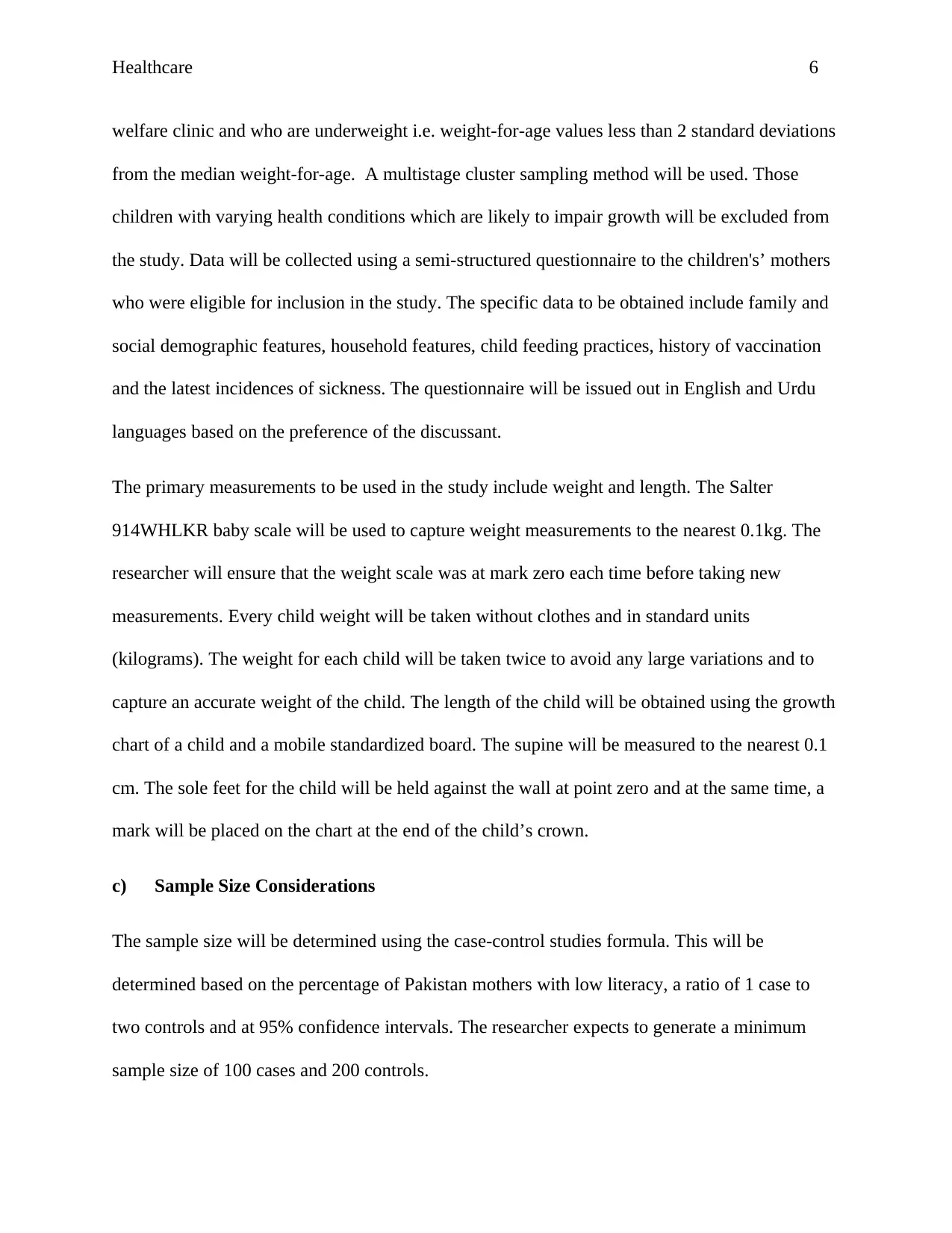
Healthcare 6
welfare clinic and who are underweight i.e. weight-for-age values less than 2 standard deviations
from the median weight-for-age. A multistage cluster sampling method will be used. Those
children with varying health conditions which are likely to impair growth will be excluded from
the study. Data will be collected using a semi-structured questionnaire to the children's’ mothers
who were eligible for inclusion in the study. The specific data to be obtained include family and
social demographic features, household features, child feeding practices, history of vaccination
and the latest incidences of sickness. The questionnaire will be issued out in English and Urdu
languages based on the preference of the discussant.
The primary measurements to be used in the study include weight and length. The Salter
914WHLKR baby scale will be used to capture weight measurements to the nearest 0.1kg. The
researcher will ensure that the weight scale was at mark zero each time before taking new
measurements. Every child weight will be taken without clothes and in standard units
(kilograms). The weight for each child will be taken twice to avoid any large variations and to
capture an accurate weight of the child. The length of the child will be obtained using the growth
chart of a child and a mobile standardized board. The supine will be measured to the nearest 0.1
cm. The sole feet for the child will be held against the wall at point zero and at the same time, a
mark will be placed on the chart at the end of the child’s crown.
c) Sample Size Considerations
The sample size will be determined using the case-control studies formula. This will be
determined based on the percentage of Pakistan mothers with low literacy, a ratio of 1 case to
two controls and at 95% confidence intervals. The researcher expects to generate a minimum
sample size of 100 cases and 200 controls.
welfare clinic and who are underweight i.e. weight-for-age values less than 2 standard deviations
from the median weight-for-age. A multistage cluster sampling method will be used. Those
children with varying health conditions which are likely to impair growth will be excluded from
the study. Data will be collected using a semi-structured questionnaire to the children's’ mothers
who were eligible for inclusion in the study. The specific data to be obtained include family and
social demographic features, household features, child feeding practices, history of vaccination
and the latest incidences of sickness. The questionnaire will be issued out in English and Urdu
languages based on the preference of the discussant.
The primary measurements to be used in the study include weight and length. The Salter
914WHLKR baby scale will be used to capture weight measurements to the nearest 0.1kg. The
researcher will ensure that the weight scale was at mark zero each time before taking new
measurements. Every child weight will be taken without clothes and in standard units
(kilograms). The weight for each child will be taken twice to avoid any large variations and to
capture an accurate weight of the child. The length of the child will be obtained using the growth
chart of a child and a mobile standardized board. The supine will be measured to the nearest 0.1
cm. The sole feet for the child will be held against the wall at point zero and at the same time, a
mark will be placed on the chart at the end of the child’s crown.
c) Sample Size Considerations
The sample size will be determined using the case-control studies formula. This will be
determined based on the percentage of Pakistan mothers with low literacy, a ratio of 1 case to
two controls and at 95% confidence intervals. The researcher expects to generate a minimum
sample size of 100 cases and 200 controls.
⊘ This is a preview!⊘
Do you want full access?
Subscribe today to unlock all pages.

Trusted by 1+ million students worldwide
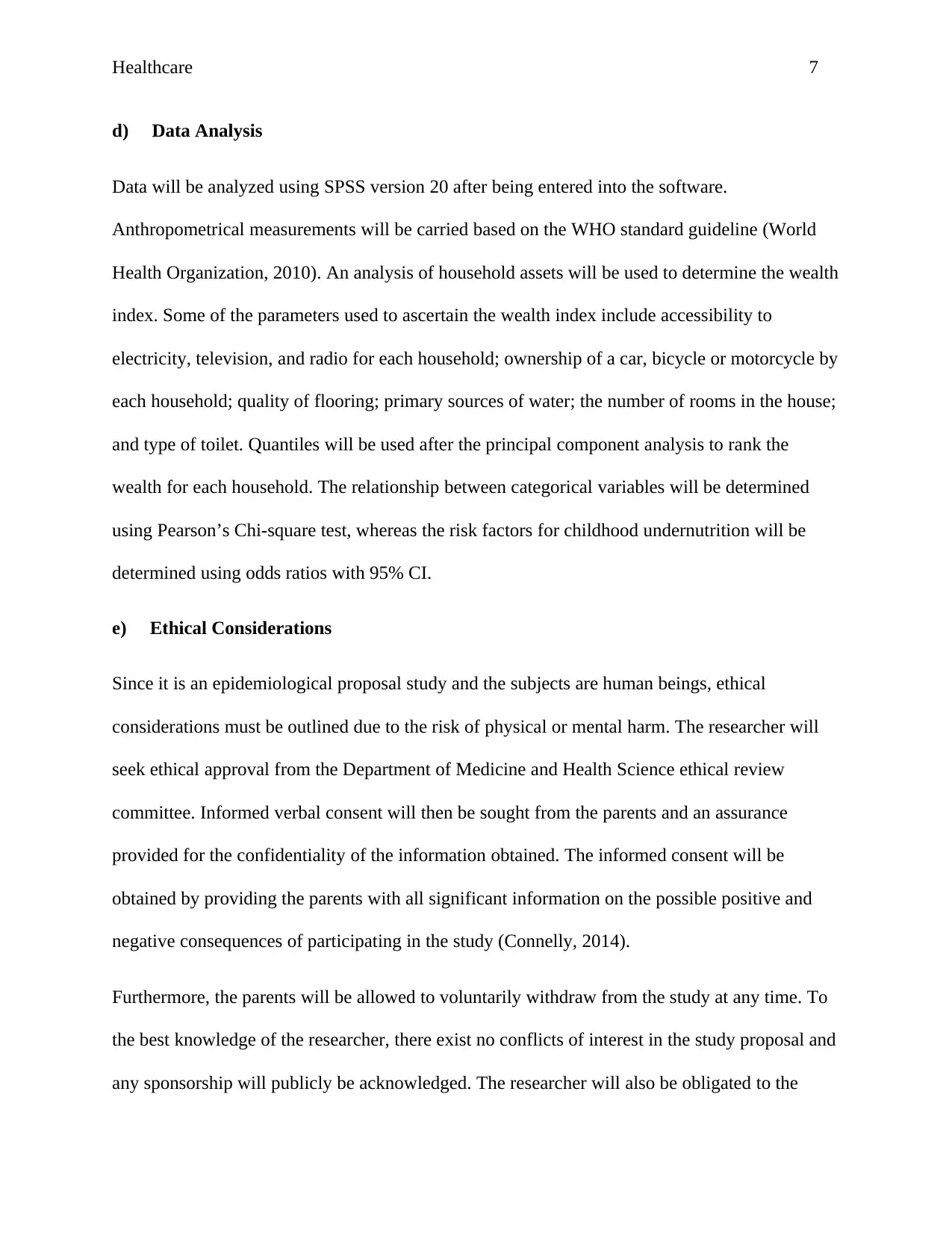
Healthcare 7
d) Data Analysis
Data will be analyzed using SPSS version 20 after being entered into the software.
Anthropometrical measurements will be carried based on the WHO standard guideline (World
Health Organization, 2010). An analysis of household assets will be used to determine the wealth
index. Some of the parameters used to ascertain the wealth index include accessibility to
electricity, television, and radio for each household; ownership of a car, bicycle or motorcycle by
each household; quality of flooring; primary sources of water; the number of rooms in the house;
and type of toilet. Quantiles will be used after the principal component analysis to rank the
wealth for each household. The relationship between categorical variables will be determined
using Pearson’s Chi-square test, whereas the risk factors for childhood undernutrition will be
determined using odds ratios with 95% CI.
e) Ethical Considerations
Since it is an epidemiological proposal study and the subjects are human beings, ethical
considerations must be outlined due to the risk of physical or mental harm. The researcher will
seek ethical approval from the Department of Medicine and Health Science ethical review
committee. Informed verbal consent will then be sought from the parents and an assurance
provided for the confidentiality of the information obtained. The informed consent will be
obtained by providing the parents with all significant information on the possible positive and
negative consequences of participating in the study (Connelly, 2014).
Furthermore, the parents will be allowed to voluntarily withdraw from the study at any time. To
the best knowledge of the researcher, there exist no conflicts of interest in the study proposal and
any sponsorship will publicly be acknowledged. The researcher will also be obligated to the
d) Data Analysis
Data will be analyzed using SPSS version 20 after being entered into the software.
Anthropometrical measurements will be carried based on the WHO standard guideline (World
Health Organization, 2010). An analysis of household assets will be used to determine the wealth
index. Some of the parameters used to ascertain the wealth index include accessibility to
electricity, television, and radio for each household; ownership of a car, bicycle or motorcycle by
each household; quality of flooring; primary sources of water; the number of rooms in the house;
and type of toilet. Quantiles will be used after the principal component analysis to rank the
wealth for each household. The relationship between categorical variables will be determined
using Pearson’s Chi-square test, whereas the risk factors for childhood undernutrition will be
determined using odds ratios with 95% CI.
e) Ethical Considerations
Since it is an epidemiological proposal study and the subjects are human beings, ethical
considerations must be outlined due to the risk of physical or mental harm. The researcher will
seek ethical approval from the Department of Medicine and Health Science ethical review
committee. Informed verbal consent will then be sought from the parents and an assurance
provided for the confidentiality of the information obtained. The informed consent will be
obtained by providing the parents with all significant information on the possible positive and
negative consequences of participating in the study (Connelly, 2014).
Furthermore, the parents will be allowed to voluntarily withdraw from the study at any time. To
the best knowledge of the researcher, there exist no conflicts of interest in the study proposal and
any sponsorship will publicly be acknowledged. The researcher will also be obligated to the
Paraphrase This Document
Need a fresh take? Get an instant paraphrase of this document with our AI Paraphraser
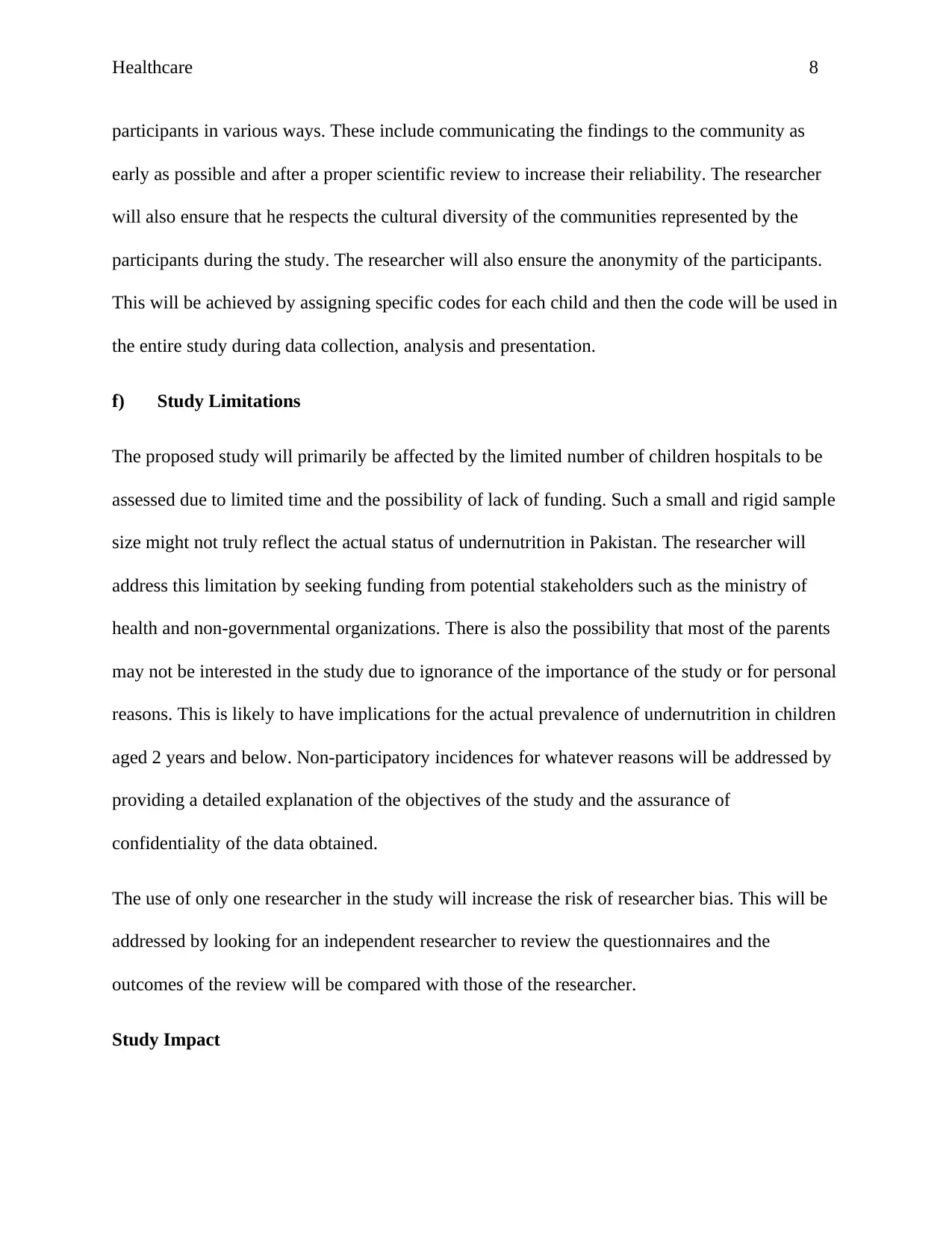
Healthcare 8
participants in various ways. These include communicating the findings to the community as
early as possible and after a proper scientific review to increase their reliability. The researcher
will also ensure that he respects the cultural diversity of the communities represented by the
participants during the study. The researcher will also ensure the anonymity of the participants.
This will be achieved by assigning specific codes for each child and then the code will be used in
the entire study during data collection, analysis and presentation.
f) Study Limitations
The proposed study will primarily be affected by the limited number of children hospitals to be
assessed due to limited time and the possibility of lack of funding. Such a small and rigid sample
size might not truly reflect the actual status of undernutrition in Pakistan. The researcher will
address this limitation by seeking funding from potential stakeholders such as the ministry of
health and non-governmental organizations. There is also the possibility that most of the parents
may not be interested in the study due to ignorance of the importance of the study or for personal
reasons. This is likely to have implications for the actual prevalence of undernutrition in children
aged 2 years and below. Non-participatory incidences for whatever reasons will be addressed by
providing a detailed explanation of the objectives of the study and the assurance of
confidentiality of the data obtained.
The use of only one researcher in the study will increase the risk of researcher bias. This will be
addressed by looking for an independent researcher to review the questionnaires and the
outcomes of the review will be compared with those of the researcher.
Study Impact
participants in various ways. These include communicating the findings to the community as
early as possible and after a proper scientific review to increase their reliability. The researcher
will also ensure that he respects the cultural diversity of the communities represented by the
participants during the study. The researcher will also ensure the anonymity of the participants.
This will be achieved by assigning specific codes for each child and then the code will be used in
the entire study during data collection, analysis and presentation.
f) Study Limitations
The proposed study will primarily be affected by the limited number of children hospitals to be
assessed due to limited time and the possibility of lack of funding. Such a small and rigid sample
size might not truly reflect the actual status of undernutrition in Pakistan. The researcher will
address this limitation by seeking funding from potential stakeholders such as the ministry of
health and non-governmental organizations. There is also the possibility that most of the parents
may not be interested in the study due to ignorance of the importance of the study or for personal
reasons. This is likely to have implications for the actual prevalence of undernutrition in children
aged 2 years and below. Non-participatory incidences for whatever reasons will be addressed by
providing a detailed explanation of the objectives of the study and the assurance of
confidentiality of the data obtained.
The use of only one researcher in the study will increase the risk of researcher bias. This will be
addressed by looking for an independent researcher to review the questionnaires and the
outcomes of the review will be compared with those of the researcher.
Study Impact
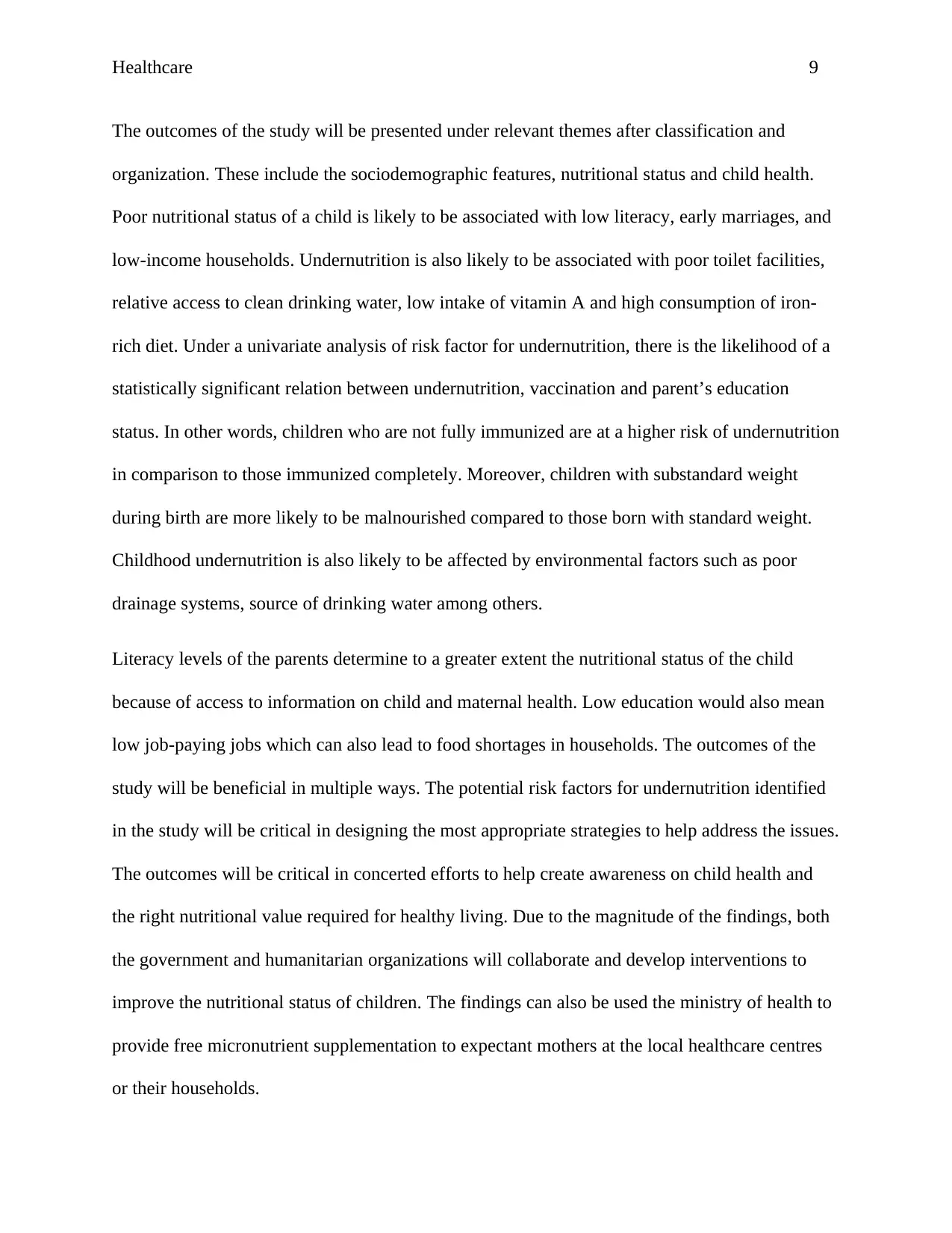
Healthcare 9
The outcomes of the study will be presented under relevant themes after classification and
organization. These include the sociodemographic features, nutritional status and child health.
Poor nutritional status of a child is likely to be associated with low literacy, early marriages, and
low-income households. Undernutrition is also likely to be associated with poor toilet facilities,
relative access to clean drinking water, low intake of vitamin A and high consumption of iron-
rich diet. Under a univariate analysis of risk factor for undernutrition, there is the likelihood of a
statistically significant relation between undernutrition, vaccination and parent’s education
status. In other words, children who are not fully immunized are at a higher risk of undernutrition
in comparison to those immunized completely. Moreover, children with substandard weight
during birth are more likely to be malnourished compared to those born with standard weight.
Childhood undernutrition is also likely to be affected by environmental factors such as poor
drainage systems, source of drinking water among others.
Literacy levels of the parents determine to a greater extent the nutritional status of the child
because of access to information on child and maternal health. Low education would also mean
low job-paying jobs which can also lead to food shortages in households. The outcomes of the
study will be beneficial in multiple ways. The potential risk factors for undernutrition identified
in the study will be critical in designing the most appropriate strategies to help address the issues.
The outcomes will be critical in concerted efforts to help create awareness on child health and
the right nutritional value required for healthy living. Due to the magnitude of the findings, both
the government and humanitarian organizations will collaborate and develop interventions to
improve the nutritional status of children. The findings can also be used the ministry of health to
provide free micronutrient supplementation to expectant mothers at the local healthcare centres
or their households.
The outcomes of the study will be presented under relevant themes after classification and
organization. These include the sociodemographic features, nutritional status and child health.
Poor nutritional status of a child is likely to be associated with low literacy, early marriages, and
low-income households. Undernutrition is also likely to be associated with poor toilet facilities,
relative access to clean drinking water, low intake of vitamin A and high consumption of iron-
rich diet. Under a univariate analysis of risk factor for undernutrition, there is the likelihood of a
statistically significant relation between undernutrition, vaccination and parent’s education
status. In other words, children who are not fully immunized are at a higher risk of undernutrition
in comparison to those immunized completely. Moreover, children with substandard weight
during birth are more likely to be malnourished compared to those born with standard weight.
Childhood undernutrition is also likely to be affected by environmental factors such as poor
drainage systems, source of drinking water among others.
Literacy levels of the parents determine to a greater extent the nutritional status of the child
because of access to information on child and maternal health. Low education would also mean
low job-paying jobs which can also lead to food shortages in households. The outcomes of the
study will be beneficial in multiple ways. The potential risk factors for undernutrition identified
in the study will be critical in designing the most appropriate strategies to help address the issues.
The outcomes will be critical in concerted efforts to help create awareness on child health and
the right nutritional value required for healthy living. Due to the magnitude of the findings, both
the government and humanitarian organizations will collaborate and develop interventions to
improve the nutritional status of children. The findings can also be used the ministry of health to
provide free micronutrient supplementation to expectant mothers at the local healthcare centres
or their households.
⊘ This is a preview!⊘
Do you want full access?
Subscribe today to unlock all pages.

Trusted by 1+ million students worldwide
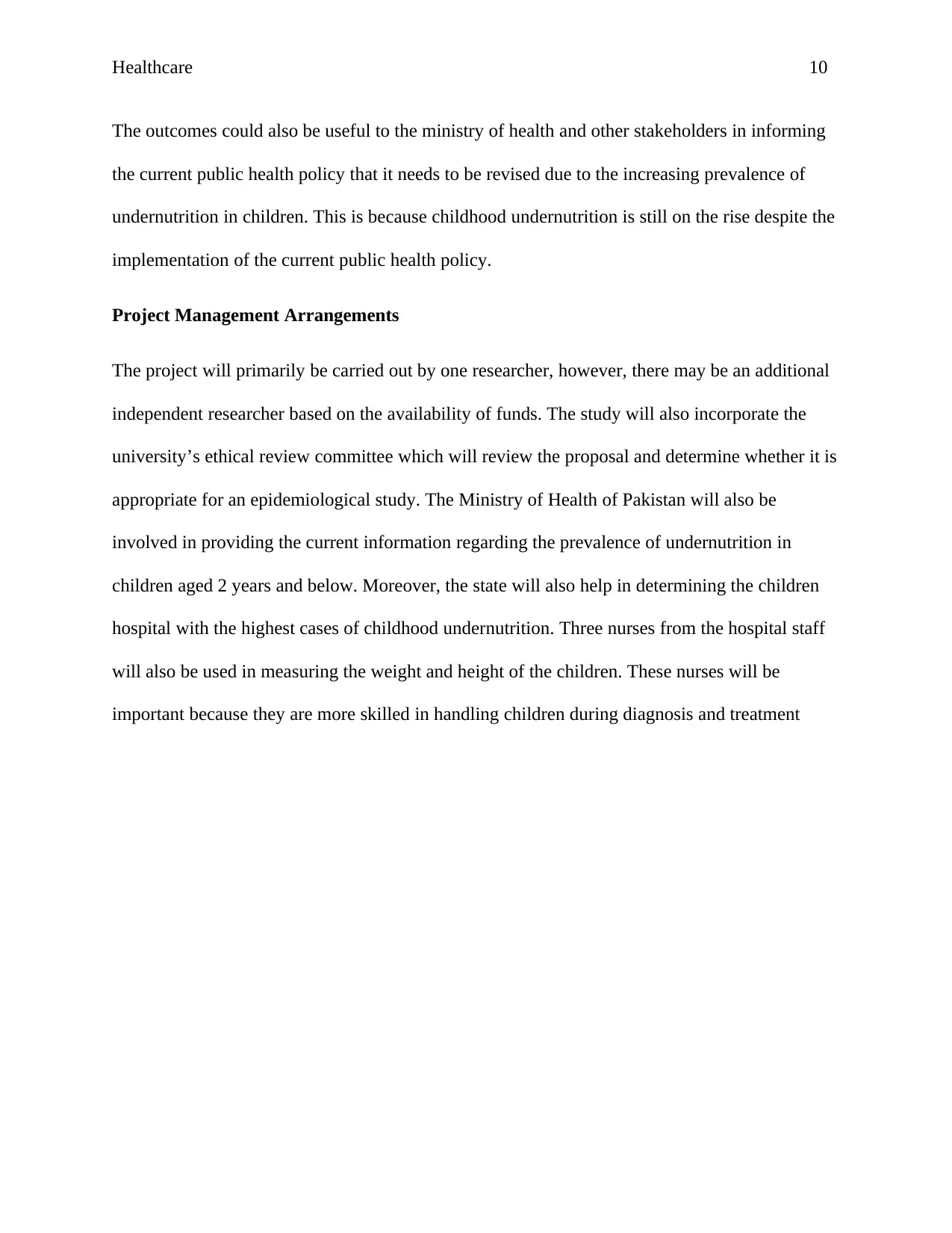
Healthcare 10
The outcomes could also be useful to the ministry of health and other stakeholders in informing
the current public health policy that it needs to be revised due to the increasing prevalence of
undernutrition in children. This is because childhood undernutrition is still on the rise despite the
implementation of the current public health policy.
Project Management Arrangements
The project will primarily be carried out by one researcher, however, there may be an additional
independent researcher based on the availability of funds. The study will also incorporate the
university’s ethical review committee which will review the proposal and determine whether it is
appropriate for an epidemiological study. The Ministry of Health of Pakistan will also be
involved in providing the current information regarding the prevalence of undernutrition in
children aged 2 years and below. Moreover, the state will also help in determining the children
hospital with the highest cases of childhood undernutrition. Three nurses from the hospital staff
will also be used in measuring the weight and height of the children. These nurses will be
important because they are more skilled in handling children during diagnosis and treatment
The outcomes could also be useful to the ministry of health and other stakeholders in informing
the current public health policy that it needs to be revised due to the increasing prevalence of
undernutrition in children. This is because childhood undernutrition is still on the rise despite the
implementation of the current public health policy.
Project Management Arrangements
The project will primarily be carried out by one researcher, however, there may be an additional
independent researcher based on the availability of funds. The study will also incorporate the
university’s ethical review committee which will review the proposal and determine whether it is
appropriate for an epidemiological study. The Ministry of Health of Pakistan will also be
involved in providing the current information regarding the prevalence of undernutrition in
children aged 2 years and below. Moreover, the state will also help in determining the children
hospital with the highest cases of childhood undernutrition. Three nurses from the hospital staff
will also be used in measuring the weight and height of the children. These nurses will be
important because they are more skilled in handling children during diagnosis and treatment
Paraphrase This Document
Need a fresh take? Get an instant paraphrase of this document with our AI Paraphraser
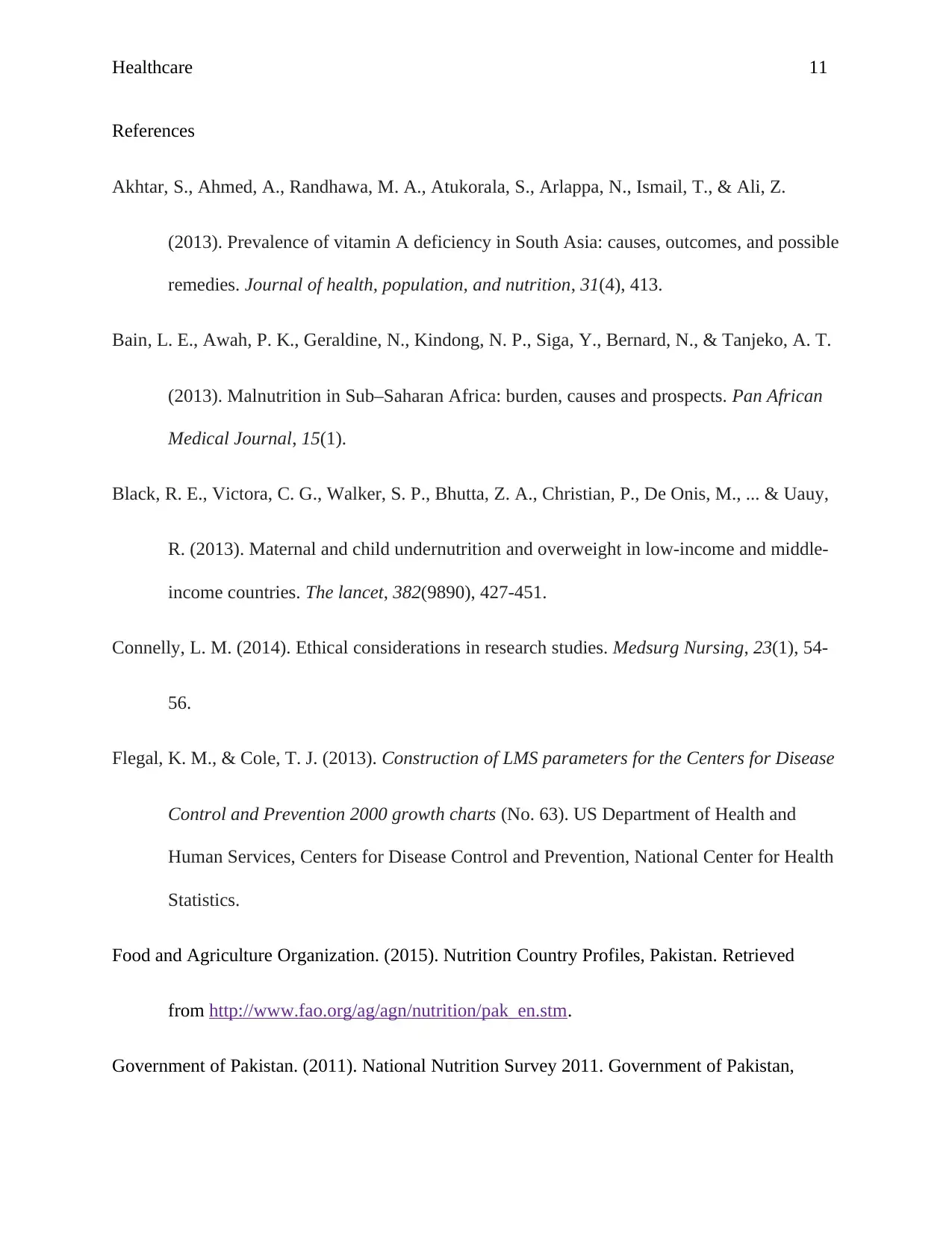
Healthcare 11
References
Akhtar, S., Ahmed, A., Randhawa, M. A., Atukorala, S., Arlappa, N., Ismail, T., & Ali, Z.
(2013). Prevalence of vitamin A deficiency in South Asia: causes, outcomes, and possible
remedies. Journal of health, population, and nutrition, 31(4), 413.
Bain, L. E., Awah, P. K., Geraldine, N., Kindong, N. P., Siga, Y., Bernard, N., & Tanjeko, A. T.
(2013). Malnutrition in Sub–Saharan Africa: burden, causes and prospects. Pan African
Medical Journal, 15(1).
Black, R. E., Victora, C. G., Walker, S. P., Bhutta, Z. A., Christian, P., De Onis, M., ... & Uauy,
R. (2013). Maternal and child undernutrition and overweight in low-income and middle-
income countries. The lancet, 382(9890), 427-451.
Connelly, L. M. (2014). Ethical considerations in research studies. Medsurg Nursing, 23(1), 54-
56.
Flegal, K. M., & Cole, T. J. (2013). Construction of LMS parameters for the Centers for Disease
Control and Prevention 2000 growth charts (No. 63). US Department of Health and
Human Services, Centers for Disease Control and Prevention, National Center for Health
Statistics.
Food and Agriculture Organization. (2015). Nutrition Country Profiles, Pakistan. Retrieved
from http://www.fao.org/ag/agn/nutrition/pak_en.stm.
Government of Pakistan. (2011). National Nutrition Survey 2011. Government of Pakistan,
References
Akhtar, S., Ahmed, A., Randhawa, M. A., Atukorala, S., Arlappa, N., Ismail, T., & Ali, Z.
(2013). Prevalence of vitamin A deficiency in South Asia: causes, outcomes, and possible
remedies. Journal of health, population, and nutrition, 31(4), 413.
Bain, L. E., Awah, P. K., Geraldine, N., Kindong, N. P., Siga, Y., Bernard, N., & Tanjeko, A. T.
(2013). Malnutrition in Sub–Saharan Africa: burden, causes and prospects. Pan African
Medical Journal, 15(1).
Black, R. E., Victora, C. G., Walker, S. P., Bhutta, Z. A., Christian, P., De Onis, M., ... & Uauy,
R. (2013). Maternal and child undernutrition and overweight in low-income and middle-
income countries. The lancet, 382(9890), 427-451.
Connelly, L. M. (2014). Ethical considerations in research studies. Medsurg Nursing, 23(1), 54-
56.
Flegal, K. M., & Cole, T. J. (2013). Construction of LMS parameters for the Centers for Disease
Control and Prevention 2000 growth charts (No. 63). US Department of Health and
Human Services, Centers for Disease Control and Prevention, National Center for Health
Statistics.
Food and Agriculture Organization. (2015). Nutrition Country Profiles, Pakistan. Retrieved
from http://www.fao.org/ag/agn/nutrition/pak_en.stm.
Government of Pakistan. (2011). National Nutrition Survey 2011. Government of Pakistan,
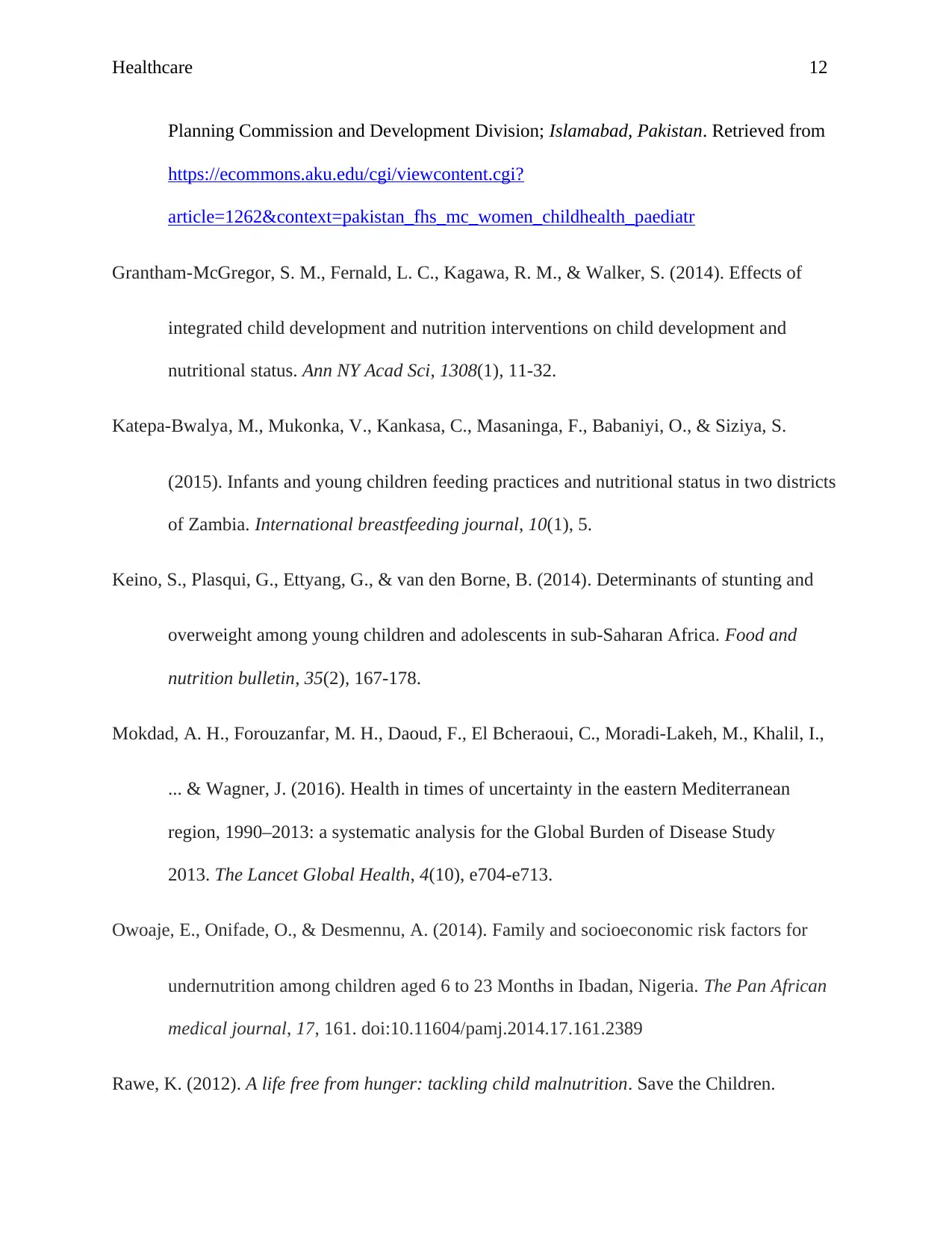
Healthcare 12
Planning Commission and Development Division; Islamabad, Pakistan. Retrieved from
https://ecommons.aku.edu/cgi/viewcontent.cgi?
article=1262&context=pakistan_fhs_mc_women_childhealth_paediatr
Grantham-McGregor, S. M., Fernald, L. C., Kagawa, R. M., & Walker, S. (2014). Effects of
integrated child development and nutrition interventions on child development and
nutritional status. Ann NY Acad Sci, 1308(1), 11-32.
Katepa-Bwalya, M., Mukonka, V., Kankasa, C., Masaninga, F., Babaniyi, O., & Siziya, S.
(2015). Infants and young children feeding practices and nutritional status in two districts
of Zambia. International breastfeeding journal, 10(1), 5.
Keino, S., Plasqui, G., Ettyang, G., & van den Borne, B. (2014). Determinants of stunting and
overweight among young children and adolescents in sub-Saharan Africa. Food and
nutrition bulletin, 35(2), 167-178.
Mokdad, A. H., Forouzanfar, M. H., Daoud, F., El Bcheraoui, C., Moradi-Lakeh, M., Khalil, I.,
... & Wagner, J. (2016). Health in times of uncertainty in the eastern Mediterranean
region, 1990–2013: a systematic analysis for the Global Burden of Disease Study
2013. The Lancet Global Health, 4(10), e704-e713.
Owoaje, E., Onifade, O., & Desmennu, A. (2014). Family and socioeconomic risk factors for
undernutrition among children aged 6 to 23 Months in Ibadan, Nigeria. The Pan African
medical journal, 17, 161. doi:10.11604/pamj.2014.17.161.2389
Rawe, K. (2012). A life free from hunger: tackling child malnutrition. Save the Children.
Planning Commission and Development Division; Islamabad, Pakistan. Retrieved from
https://ecommons.aku.edu/cgi/viewcontent.cgi?
article=1262&context=pakistan_fhs_mc_women_childhealth_paediatr
Grantham-McGregor, S. M., Fernald, L. C., Kagawa, R. M., & Walker, S. (2014). Effects of
integrated child development and nutrition interventions on child development and
nutritional status. Ann NY Acad Sci, 1308(1), 11-32.
Katepa-Bwalya, M., Mukonka, V., Kankasa, C., Masaninga, F., Babaniyi, O., & Siziya, S.
(2015). Infants and young children feeding practices and nutritional status in two districts
of Zambia. International breastfeeding journal, 10(1), 5.
Keino, S., Plasqui, G., Ettyang, G., & van den Borne, B. (2014). Determinants of stunting and
overweight among young children and adolescents in sub-Saharan Africa. Food and
nutrition bulletin, 35(2), 167-178.
Mokdad, A. H., Forouzanfar, M. H., Daoud, F., El Bcheraoui, C., Moradi-Lakeh, M., Khalil, I.,
... & Wagner, J. (2016). Health in times of uncertainty in the eastern Mediterranean
region, 1990–2013: a systematic analysis for the Global Burden of Disease Study
2013. The Lancet Global Health, 4(10), e704-e713.
Owoaje, E., Onifade, O., & Desmennu, A. (2014). Family and socioeconomic risk factors for
undernutrition among children aged 6 to 23 Months in Ibadan, Nigeria. The Pan African
medical journal, 17, 161. doi:10.11604/pamj.2014.17.161.2389
Rawe, K. (2012). A life free from hunger: tackling child malnutrition. Save the Children.
⊘ This is a preview!⊘
Do you want full access?
Subscribe today to unlock all pages.

Trusted by 1+ million students worldwide
1 out of 13
Related Documents
Your All-in-One AI-Powered Toolkit for Academic Success.
+13062052269
info@desklib.com
Available 24*7 on WhatsApp / Email
![[object Object]](/_next/static/media/star-bottom.7253800d.svg)
Unlock your academic potential
Copyright © 2020–2025 A2Z Services. All Rights Reserved. Developed and managed by ZUCOL.




